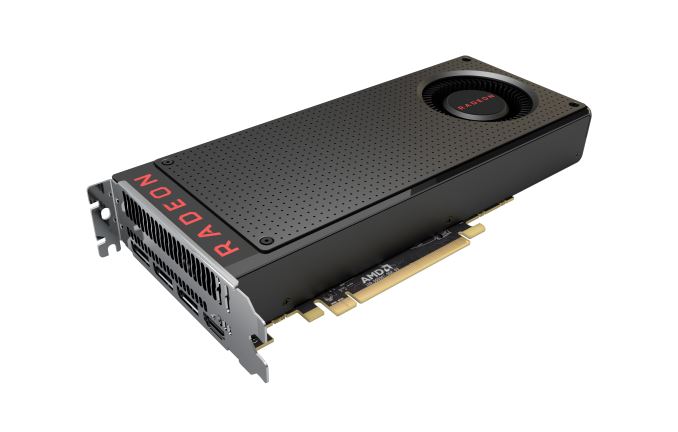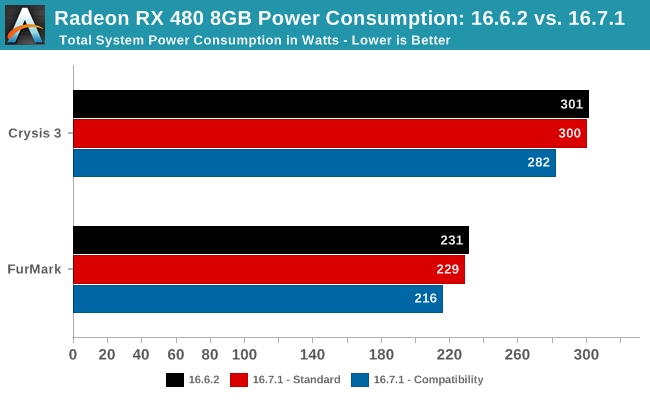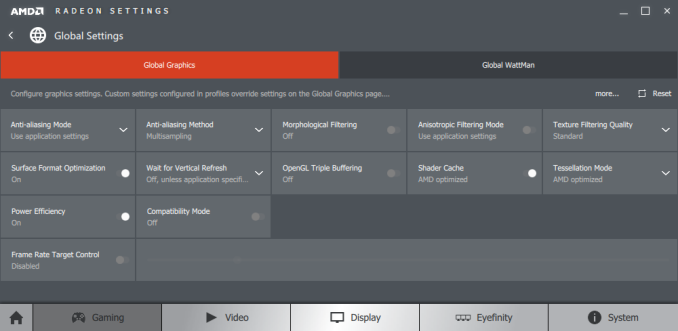AMD Posts Radeon 16.7.1 Drivers, Fixes RX 480 Power Consumption Issues
by Ryan Smith on July 7, 2016 6:50 PM EST
In what’s hopefully the final chapter on AMD’s saga over the last week with the Radeon RX 480’s power consumption, AMD has posted the previously promised 16.7.1 driver set on their website.
As a reminder, 16.7.1 is being released first and foremost to address RX 480’s power consumption issues, in which reviewers found that it was drawing too much power from the PCIe graphics (PEG) slot, and that the total power consumption of the card was at times exceeding 150W, which is the technical limit for a card with a 6-pin power connector. Of the two issues, PEG power consumption is arguably the greater of the two, as the external power connectors are far more forgiving.
To that end, 16.7.1 rolls out a two tier solution to the problem.
- Shift some of the power load off of the PCIe Graphics (PEG) slot connector in order to bring PEG slot power consumption within the PCIe spec. This doesn’t reduce total power consumption and performance is unaffected; power delivery is merely shifted. Based on earlier data this will put the 6-pin connector further over spec, but the vast majority of PSUs are very tolerant of this going out of spec.
- Because total power consumption of RX 480 can still exceed 150W – and as a result also exceed the limits for the 6-pin connector – AMD has also implemented an optional a “compatibility” toggle that reduces the total power consumption of the card. This is to better ensure that both the PEG slot and 6-pin power connector stay below their respective limits. Since the RX 480 is already throttling at times due to power limits, this does hurt performance (more on that below), but it's also the most standards-compliant solution.
Along with the power changes, the driver also incorporates some previously scheduled bug fixes and performance improvements. This includes fixing GTA V stuttering, and small performance boosts for a limited number of games that AMD states should improve performance by up to 3%.
Finally, the 16.7.1 driver can be found on AMD’s website. Note that the driver itself is not WHQL certified, but given AMD’s rush to get it out ASAP, I don’t imagine they were interested in waiting for WHQL certification to come back before releasing them.
Diving into matters then, PC Perspective has already taken a look at the new driver and done individual power rail measurements, finding that AMD’s fixes work more-or-less as advertised. They have found some edge cases where the card is still drawing a watt or two more power from the PEG slot than the specification allows, though at this point we’re arguing over inches. It should be noted however that even in compatibility mode, PC Perspective is still finding that power consumption is technically exceeding 75W on the 6-pin connector, though like the PEG slot by notably less than when not using compatibility mode.
Meanwhile to look at the performance impact of the new driver, I quickly ran our RX 480 through a selection of games at 2560x1440, both with and without compatibility mode.

In standard mode where power consumption isn’t curtailed, performance is essentially unchanged outside of Tomb Raider, which is one of the games targeted for optimization. Essentially this proves that there’s no performance impact from merely shifting power consumption off of the PEG slot to the 6-pin power connector.
Meanwhile in compatibility mode, there is a very small performance hit, though it varies with the game. Compared to standard mode, we’re looking at no more than a 1fps performance drop (~3%), with some games losing only a fraction of a frame per second. That there is a performance drop is consistent – so compatibility mode isn’t free – but overall the performance change is within the +/- 2% margin of error for these benchmarks.

Finally, when it comes to power consumption, measurements at the wall back up our earlier findings. In standard mode, power consumption at the wall bobbles by a couple of watts compared to the 16.6.2 drivers. With compatibility mode on, we see power consumption drop by 18W under Crysis 3, and 13W under FurMark. The average GPU clockspeed in both cases is similarly reduced, with Crysis 3 shaving off around 50MHz.
Anyhow, we’ll have a bit more on the subject in next week’s full Radeon RX 480 review. But in the meantime it looks like AMD has been able to get a handle on their power problems and largely rectify them within the span of a week, making for a fairly quick recovery on the RX 480’s launch fumble.











105 Comments
View All Comments
prisonerX - Thursday, July 7, 2016 - link
I think they figured it would fit into the power envelope and wanted the 6 pin to demonstrate that those with only that could use the card. If it has an 8 some people will say "oh I don't have an 8 it won't run on my PSU" or something along those lines.fanofanand - Friday, July 8, 2016 - link
I think you hit the nail on the head. Most lower-powered PSU's or older PSU's simply don't have an 8-pin, the casual user will simply look at that and say "I don't have that, I guess it's a 1060 for me".RussianSensation - Friday, July 8, 2016 - link
The issue here is that the 75W is not the right standard for the 6-pin cable itself. It's been explained a while back. The 75W spec is outdated as it was created in October 2004 and does not apply to modern PSUs.http://www.tomshardware.co.uk/power-supply-specifi...
BurntMyBacon - Friday, July 8, 2016 - link
The spec has not been updated, but is still in use and therefore does apply to current PSUs. The spec is, however, not limiting on the sourcing side, only the drawing side. In other words, you are not allowed to create a device that requires more than the specified amount of power and still be spec compliant. You can, however, source as much power as you want assuming your distribution method is rated to handle it.The question is why PSU and motherboard manufacturers would go to the cost and effort of making a power distribution system that is more capable than the devices that will use it. Part of the answer is that the spec compliant connectors already have that capability, so the cost and effort are both low. It also gives them more margin (and fewer RMAs) to work with. Even if it is a niche, there is the assumption of overclocking which often pushes these devices out of spec. Overclockers are few in number, but they are often the people that others come to for advice on computer builds and make up a very vocal crowd on tech sites. The marginal extra cost may be justified indirectly by making sure they don't have issues with your product when they overclock (up to a reasonable point anyways). Factory overclocks are now common place as well and not every manufacturer makes sure the power circuitry is updated to stay spec compliant.
emn13 - Friday, July 8, 2016 - link
A friend of mine builds cases, and apparently it's quite common for even basic things like plain old dimensions to be out of spec; i.e. if you build a case according the the maximum dimensions specified for ATX components many won't actually fit.It just doesn't surprise me that components are regularly out of spec; the whole industry clearly doesn't take it all that seriously.
Not to mention that a current spec on a cable is a weird thing to even want to spec. As in: I can imagine wanting to specify the maximum power the *connector* should be able to handle, but that's going to be way, way higher. Similarly, I can imagine specifying the *minimum* current a power supply must be able to deliver to be atx compliant (though that's odd too). But conversely, specifying the maximum a component may draw leads to the consequence of components using many cables for no real reason other than compliance. If there really were a reason for the limited current spec; or if the 8-pin connector (or other hypothetical connectors) provided higher ratings, there's would be a spec-valid way to use the efficient number of cables. But there's not.
See e.g. http://www.playtool.com/pages/psuconnectors/connec... which is mostly about ATX, but also analyzes PCIe power connectors: the ATX side of the story should be specced to 6-8A... *per circuit!* But the PCIe *total* current spec for all *3* circuits is less than 7A. So even with bog standard ATX circuits (as used e.g. for hard drives or the CPU), you'd expect this connector to be able to deliver at least 216W, and probably 288W.
I mean, a 100W power supply is enough for lots of devices, certainly a 150W supply. Perhaps if you really standardize to the lowest common denominator device such as that, you might get this low spec with the absurd consequence that systems using more while remaining within the spec are likely to need(*) to use many, many cables - for no particularly good reason.
(*) the 8-pin PCIe connector isn't quite as bad, but also oddly underspecced.
emn13 - Friday, July 8, 2016 - link
Incidentally, because people use (and PSU manufacturers often sell) converters between the various connectors, it's probably dangerous for a PSU to underspec a connector. Not to mention that it may even be more expensive to do so, because it means a greater diversity of components, which possibly costs more than the minute savings thinner cables might allow.Oxford Guy - Friday, July 8, 2016 - link
"Again, the question is why AMD went with a single 6-pin?"1) The connector provides enough power.
2) AMD doesn't want the card to cut into later higher tier products by giving the card's overclocking even more potential?
3) More connectors = more production cost.
emn13 - Friday, July 8, 2016 - link
Since in practice almost every 6-pin connector is probably designed to provide at least 216W (if using the same components as the HDD and/or CPU connectors) and likely considerably more, I doubt that overclocking headroom is really limited (assuming the overall total system draw is within the PSUs capability, of course). Last time I bought PSUs they came with converters between various connectors; so it's not even optional for them to support that kind of wattage.It's weird that all other components using similar connectors are specced to about 3 times the current per circuit, but well... if you're willing to spend 4500$ (https://pcisig.com/specifications/order-form#Top%2... PCI-SIG might let you in on that secret.
JasonMZW20 - Thursday, July 7, 2016 - link
So, you're not a fan of overclocking either? Any overclocked CPU is drawing much more current than it should or is rated for (manufacturer 'spec' since you're so focused on specs). Thankfully, motherboard manufacturers gave us options on that front. And your motherboard isn't frying in the process.You know the -20 to +20% power targets actually DO affect power draw, as those options either lower or raise the upper power ceiling before the card throttles itself; though WattMan gives you MUCH finer granularity, so you can undervolt if the physical silicon is capable of it. Anyway, the reference board is just that - a point of reference. It's not made to OC, because if it was, it'd most certainly have an 8-pin.
Like the AIB vendor cards that are coming soon ...
fanofanand - Friday, July 8, 2016 - link
Stop making sense.